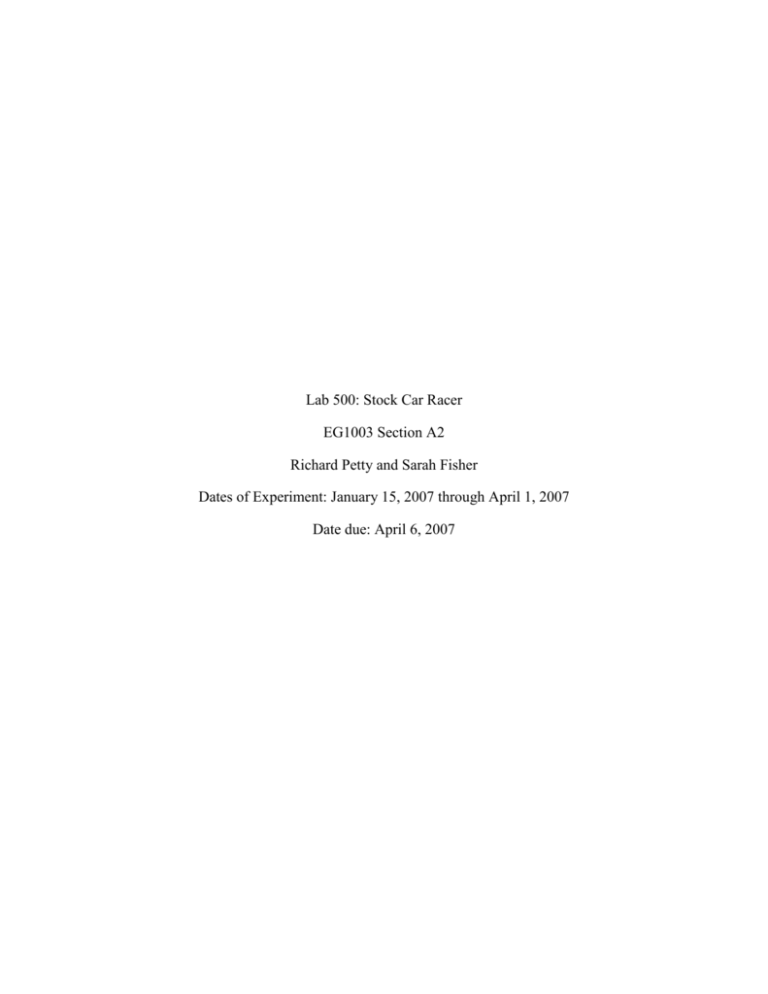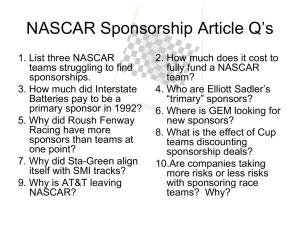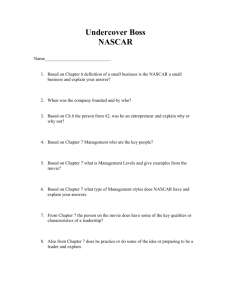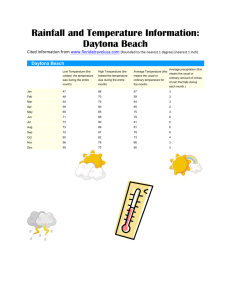Eglabrpt500
advertisement

Lab 500: Stock Car Racer EG1003 Section A2 Richard Petty and Sarah Fisher Dates of Experiment: January 15, 2007 through April 1, 2007 Date due: April 6, 2007 Abstract The objective of this lab was to build a stock car racer capable of competing in the Daytona 500 and DirecTV 500. A second objective was to win the competition between the EG1003 teams entered in these races by achieving the highest Car Competition. The car was successfully entered in both races, and the team achieved second place in the EG1003 competition. The car was run into the wall at Martinsville by another driver, causing it to finish in a much lower position than if it had been able to race at full speed, hurting the car’s Car Competition Ratio. The NASCAR car specification, with its emphasis on safety, helped the car remain competitive until the end of both races. Introduction Since the lab was a competition, the winning team was the one with the lowest Car Competition. The Car Competition Ratio is: CCR 400000 86 DaytonaPla ce Martinsvil lePlace Cost In this ratio, DaytonaPlace is the position of the car in the finishing order of the Daytona 500. Under the formula, the worse the car finished, the higher the ratio, and the lower the car would finish in the EG1003 competition. The same is true for the MartinsvillePlace term. Therefore, the car would have to finish well in both races to minimize the ratio. With the cost of the car in the denominator, the car also had to be designed to be as inexpensive as possible. Since the Daytona 500 is a high speed race on a long track, the car had to be aerodynamically efficient. However, since the Martinsville track is short and narrow, the car had to be very maneuverable as well. The NASCAR specifications are extremely specific on how the car’s design, with safety being paramount. Much of the car consisted of high strength tubing and guard rails to protect the driver. The car must also have the same overall shape as the comparable model being sold commercially so that a casual spectator will recognize it. However, the only parts of the car that must be in common with the commercial version are the hood and the trunk lid, leaving considerable flexibility in how to design the rest of the body. From some Web sites of NASCAR racing teams, it was clear that most of the non-structural body should be made of fiberglass to minimize weight. Even though the car was designed to be as inexpensive as possible, it was still very expensive at $240,390. Other cars entered in the race were much more expensive. However, it was still necessary to secure additional sponsorship, which is allowed and even encouraged under NASCAR rules. The car had Sid’s Hardware Store as its major sponsor. Procedure The following materials were used: a 2006 Chevrolet Monte Carlo, 200 feet of steel tubing, a dual electronic ignition, 400 pounds of fiberglass, a Simpson racing seat and five point safety belts, a 400 horsepower turbocharged, supercharged engine, a fuel cell to replace the stock gas tank, small tubing to connect the fuel cell to the engine, 40 sets of racing tires, cargo netting to replace the driver window, and three electrical switches. The switches were used to replace the key ignition, start the car, and provide an “Emergency Power Off” capability required by NASCAR rules. NASCAR rules also required having a complete professional race crew at the races, plus professional technicians supervising the construction of the car, so an additional labor cost was incurred as part of our materials. First, The NASCAR rules were reviewed and an initial design was determined. The Chevrolet Monte Carlo is allowed as a candidate model under NASCAR rules, and is readily available. Next, sponsorship from Sid’s Hardware was obtained, making it possible to procure all the parts. Next, a 2006 Monte Carlo was obtained. The entire body was removed, leaving only the chassis, engine and drive train. The engine was also removed and replaced by a 400 horsepower turbocharged supercharged engine. Next, a fiberglass body and dashboard were constructed to match the body of the commercial Monte Carlo, with some aerodynamic refinements allowed under NASCAR rules. Next, steel tubing was cut and welded to form the cage that acted as the passenger compartment, the attachment points for the new fiberglass body, and the attachment points for the driver safety equipment. The driver’s safety seat was attached to the tubing. The five point seat belt system was attached to the driver seat and the steel tubing. Next, the fiberglass body was lowered onto the steel tubing and attached. The stock hood and trunk lid were attached to the fiberglass, and a fiberglass spoiler was constructed to NASCAR specifications and attached to the fiberglass body. Next, The first set of racing tires was installed and the car was painted and decals provided by Sid’s Hardware were applied. Next, Richard Petty was selected to be the car driver, and the car was entered in the Daytona 500 and passed qualifications tests. After qualifying, the car was raced in the Daytona 500. After the race, some damage from the race was repaired Next, the car was entered in the DirecTV 500 and passed qualification tests. After qualifying, the car was raced in the DirecTV 500. Finally, the total cost for the car was calculated, and from the finish results of the two races the Car Competition Ratio was calculated. Since the car had the best Car Competition Ratio, the car was repaired again and displayed in the Poly lobby. The costs of these repairs were not included in the cost since they were done after the competition was over. Data/Observations The first time the car was tested was on an abandoned runway at Floyd Bennett Field, now part of the Gateway National Park. The car had much greater acceleration than the equivalent car sold in dealer showrooms. Since the car had no speedometer, the maximum speed was estimated to be about 140 miles per hour. The car was packed up in a trailer rented from U-Haul and taken to Daytona. The car was tested on the actual track that would be used for the race, and a speed gun was used to determine the top speed of the car. A top speed of 160 miles per hour was recorded. The car had to pass qualification tests for conformity to NASCAR rules, and be among the fastest 43 cars during qualification trials. The car had the tenth fastest time during qualification trails with a speed of 195 miles per hour, putting it on the outside of the fifth row of the starting grid for the race itself. During qualification, a top speed of 200 miles per hour was recorded. The car finished eighth in the race, which was much higher than expected. Some damage to the car was sustained when another car slid into the race car. This damage was repaired with no major problems, and the car was taken to Martinsville. Once again, the car had to pass qualification and be among the fastest 43 cars. This time the car placed in 24th place, putting it on the outside of the twelfth row of the starting grid. The car finished 28th in the race, largely because the Number 20 car hit the car and pushed it into the wall. The Sid’s Hardware decals were observed by that driver. The Number 20 car is sponsored by Home Depot. The damage to the car was extensive, and the time needed for repairs caused the car to finish much lower in the standings that if the car had not been damaged. Discussion/Conclusions After the DirecTV 500 race, the car was shipped back to Brooklyn in the U-Haul trailer, and the final cost was calculated. The following is the cost breakdown: Item 2006 “Stock” Monte Carlo Steel tubing Ignition Fiberglass Seat and safety belts Engine Fuel cell Fuel tubing Tires Cargo netting Switches Labor Unit Cost Unit of Measure Quantity Total Cost $25,000 Each 1 $25,000 $20 Foot 200 $4,000 $2,000 Each 1 $2,000 $20 Pound 400 $8,000 $5,000 Each 1 $5,000 $8,000 Each 1 $8,000 $200 Each 1 $200 $5 Foot 15 $75 $500 Set 40 $20,000 $10 Square foot 10 $100 $5 Each 3 $15 $200 Hour 840 $168,000 Grand Total $240,390 From the above data, the Car Competition Ratio was calculated: CCR 400000 86 DaytonaPla ce Martinsvil lePlace 400000 86 8 28 83.1981 Cost 240390 The results of the EG1003 competition are shown in the following table: Team Daytona Place Martinsville Place Elmer and Bugs 35 41 Micky and Minnie Didn't qualify 30 Richard and Sarah 8 28 Jim and Lenny 7 10 Cost 150654 240390 240390 395062 CCR Position 26.5509 3 DQ 4 83.1981 1 69.8625 2 Overall, the car came in first place in the EG1003 competition, primarily because of its excellent finish at Daytona. The pit crew at Martinsville was also extremely adept at fixing the car quickly and getting it back on the track without losing too many places. The costs of several other cars were also significantly higher than our car, causing the CCR of the other cars to be lower. The car could be improved by making it quicker to have body parts repaired or replaced, saving time on repairs and minimizing time lost. A second improvement, probably not allowed by NASCAR rules, would be to mount twin 50 caliber machine guns at the front of the car to defend the car from attackers.





